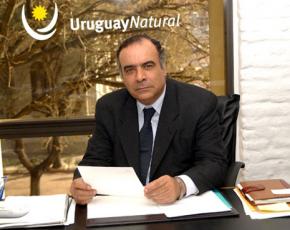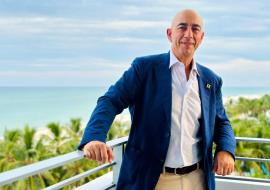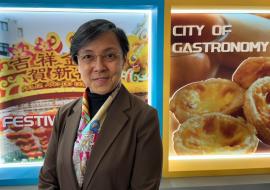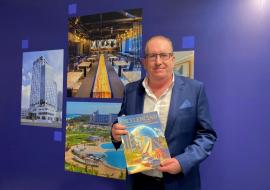Hector Lescano, Minister of Tourism and Sport in Uruguay

Under the brand “Uruguay Natural”, the South American country promotes a diverse travel product that includes sun and beach, MICE, rural tourism or thermals. Our interviewee also points out the cultural diversity and rich cuisine among the destination’s positive elements, which looks with growing interest at such markets as Russia.
What would be, in your opinion, the characteristics that make Uruguay a special destination?
Uruguay features internationally acclaimed beaches and spas, such as Punta del Este, but also historic cities, traditional parties, all of them in constant development. The tourism offer includes sun and beach (with Rocha ocean shore standing out), thermals, sport (surf, golf and fishing), MICE and natural spaces, where adventure tourism, ecotourism and rural tourism are to be highlighted.
Its building heritage, the transportation, medical assistance and hotel services in historical sites such as Colonia del Sacramento (declared Mankind Heritage by UNESCO), make up a varied travel offer that is summarized in the “brand country”: Uruguay Natural.
Some distinctive factors, such as the short distances backed up by an excellent road network and the people, naturally kind and highly educated, come together to turn this country into an attractive place for regional and international tourism.
Russian tourists have specific characteristics: they are starting to travel and mainly prefer all-included packages, and, on the other hand, they love culture and their spending level goes beyond the average. What destinations is Uruguay offering for this market? What’s your best shot for these Russian tourists?
Due to its history and vocation, our country is a place of cultural encounter, where different artistic expressions coexist and reflect the communities of migrants that arrive in the country between the first half of 19th century and the early 20th. Most of them were Hispanics, Italians or French, although the Russian community in San Javier is also to be highlighted, as it has been based in our territory for almost 100 years.
These migrant cultures converged with deeply rooted cultural expressions in the country, like the traditions related to the gaucho or the Afro descendant community. This one, through its music, has contributed with the candombe to make up an important part of the national identity. Talking about Uruguay is also talking about tango, a typical expression from Rio del Plata region that spiritually unites the people from Argentina and Uruguay.
But there is also a long-standing tradition of classic cultural expressions. Opera seasons are alternated with the activity of SODRE’s Ballet, directed by MasterJulio Boca;all of which have privileged stages due to their patrimonial and architectural value: Solis Theater and SODRE Auditorium, both located in the capital, Montevideo.
What kind of promotion campaigns are you presently carrying out in the Russian market?
Our Ministry is studying the participation in some of the specialized fairs in the travel sector. Our idea is promoting tourism products through our Uruguay Natural brand, repeating successful experiences along with the National Institute of Meat (INAC) or the INAVI (National Institute of Wine), when, for instance, we made up a national booth during the Universal Expo Shanghai 2010.
Uruguay is a country with excellent cuisine traditions. Do you combine tourism advertising campaigns with the promotion of products? Is there any offer for tourists specialized in this matter?
Gastronomy occupies an important position in the identity of the people. Uruguay has the privilege of being a great food producer in terms of variety and quality. Undoubtedly, the beef plays an important role in the national cuisine and is included in several dishes.
The country, after many year of hard work, has restructured its viniculture, which presently holds several international recognitions, mainly prizes awarded to its national stock: Tanat. It also develops high-quality products such as olive oils, goat cheese and caviar, within the framework of a wider offer of life quality linked to Uruguay Natural.
The gastronomic offer has been increased, with the country’s capital standing out due to the variety, which includes popular dishes and gourmet cuisine, present in Montevideo’s Gastronomic Catalogue, sponsored by our Ministry.
Argentina and Uruguay share cultural references like tango, gastronomy and soccer. Each one of us is located in one of Rio de la Plata shores, important tourism enclave in the region. How do the companies from both countries deal with the competition in this zone? Does the competition prevail or some cooperation actions have been implemented, such as tourism routes in both shores?
The presence of Argentinean tourists at regional level has an important implication in quantitative and qualitative terms. The tourism flow coming from the neighbor country is very important. So much so that many Argentineans possess their second residency in Punta del Este and represent a significant “driving force” for sun and beach tourism. Their presence can be also noted in the littoral of Uruguay river, specifically in the thermal zone.
Colonia del Sacramento city is a natural entry door from Buenos Aires, capital of Argentina, located atless than 50 kilometers, crossing Rio de la Plata. It’s also an example of the complementarity of these travel destinations, since you can observe the daily arrival of international tourists coming from Argentina.
Its most popular destination, Punta del Este, is sited right at the edge of the Uruguayan shore. What are the growing prospects and what’s to be expected in the future? Is there any special training to deal with Russian tourists?
Punta del Este is a fascinating destination because of the abundant nature in the area and the quality of services provided. Russian tourists will be certainly dazzled by its charm and glamour.
The creation of Punta del Este Convention Center, for congresses, conferences and meetings, an answer to the interest of 24 international companies, is currently in the phase of International Tender. It’s an important objective for the Ministry and will certainly boost Punta del Este as regional and international travel destination.
As for the specialization, it’s very important to know Russian culture and language. Is there any agreement between both countries targeting tourism in this sense?
We think that signing a cooperation agreement with our Russian colleagues in terms of tourism would great. Our nations have taken a significant decision in terms of the annulation of tourist visa between both countries.
I’d like to point out the presence of Russian migrants in Uruguay since 1913. They have cultivated their traditions, their parties and, of course, their language. We are aware of the support provided by Russia’s Embassy in Montevideo to San Javier colony and the important role played in spreading the Russian language. Our country annually celebrates the World Day of Russian Language at “Federacion Rusa” School, in Montevideo. We also remember the Day of the Victory in the Great Homeland War and recently paid tribute to the 50th anniversary of Yuri Gagarin flying to the cosmos.
Uruguay has recently launched a brand-new destination, La Ruta del Arroz (The Route of Rice). What can you tell us about it? Is there any other alternative route?
La Ruta del Arroz joins the capitals of Rocha and Treinta y Tres. This route combines the opportunity of getting in touch with an agro exporting zone and its people, with a gastronomic offer based in rice at Vergara city, or gaining access to an Interpretative Center in Lascano city.
Cebollatí city, considered the “Capital del Arroz” (Capital of Rice), not only stands out due to productive aspects, but also because of the biodiversity, with over 700 vegetable species at less than 15 kilometers from Laguna Merín, natural frontier with Brazil.
The Festival del Arroz (Rice Festival) is held in August at Villa Isidoro Noblía, sited 45 km away from the capital of Cerro Largo, with a parade of agricultural machinery and airplanes flying over the town and baptizing it with a rain of rice. Likewise, there is a cuisine contest with rice-based recipes of salads and desserts, where women and men from the zone showcase the best of their cuisine tradition.
What can you tell us about the flow of Russian tourists to Uruguay? Has it been increased if compared with previous years?
Our authorities confirm a steady growth since 2009, with an average of 900 Russian tourists.In 2012, up to February, we had already checked in 400 tourists, so we foresee an increase in the number of visitors.
How important is the Russian market for Uruguay?
On September 26, 2011, in Nueva York, we signed an agreement so Uruguay and Russia eliminated the visa regime between both countries.
Besides representing a concrete move, it’s a great opportunity to boost an approach between the Russian Federation and the Eastern Republic of Uruguay, promoting the travel activity along with the significant trade flow between both nations. As a destination of Uruguayan beef exportation, Russia is the main market in terms of volume, including the significant exportations of fat, cheese, wine and soy. On the other hand, Russia is the third oil provider for Uruguay.
Eliminating a visa regime between countries represents a complex process and several factors must be taken into account. What were the main elements that favored the elimination of a visa regime with a county like Russia?
The obliteration of travel visa positions our country at the same level of other Latin American nations such as, Brazil, Chile, Peruand Venezuela. It also expresses a will of world opening and strengthening of historic ties with the Russian Federation.
Airlines in Russia impose their law to travel tour operators, what turns out to be the opposite in other countries. It means that the tourism outbound isn’t as much as you want or as frequent as you’d like in some cases. How is the airlift between Uruguay and Russia?
We can affirm that Uruguay is substantially improving its connectivity with the region and the world. As example we have the port in Montevideo, which has recently become a boarding and disembarking port for cruise passengers.
The cruise activity has experienced a steady growth and 215 cruisers have arrived in the ports of Punta del Este and Montevideo during the 2011-2012 season. As for airlift, we don’t have non-scale flights between Moscow and Montevideo. The airlift between both capitals depends on flights connected to Buenos Aires, Sao Paulo or Madrid.
How does Uruguay take advantage of its privileged geographical position, as entry door to South America?
Being the administrative capital of MERCOSUR and its Parliament (PARLASUR) entails a huge challenge. There is excellent airlift with the capitals of the member countries of MERCOSUR, as well as Chile and Peru.
Montevideo’s port emerges as regional logistic center and stands out as natural port, and also represents an entry door for regional and international tourism.














